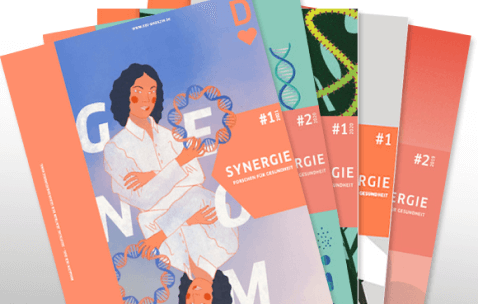Translation
One of the main goals of the German Centers for Health Research (DZG) is to translate the findings gained by their researchers in laboratories across Germany into medical practice. This process is called translation. The DZG aim to accelerate the safe and successful application of new medical knowledge by fostering close collaboration between university-based and non-university research. Translation takes place in phases: On this page we show examples of how DZG projects are active in the individual phases.
Filter by DZG
Navigate to Translation Phases
"Preclinical" refers to fundamental research in the laboratory aimed at understanding disease mechanisms and establishing a solid foundation for future developments.
The DZNE, in collaboration with the Dutch company Intravacc, is working on a vaccine for a specific form of Amyotrophic Lateral Sclerosis (ALS). The goal is to optimize a drug prototype developed by DZNE so that it can be tested in patients. ALS is an incurable neurological disease that causes paralysis and usually leads to death within a few years. There are different variants of ALS, some of which are hereditary. The planned vaccine targets the most common genetically caused form of ALS: Unlike in most people, individuals with this variant have an unusually high number of repetitions of a particular DNA sequence in a normally silent section of the C9orf72 gene. This leads to the formation of toxic proteins, particularly long poly-Glycine-Alanine chains. The vaccine aims to trigger the production of antibodies against these proteins in order to neutralize them. This research project is also supported by the EU through an "EIC Transition Grant" worth 2.5 million euros.
Researchers at DZNE and Charité – Universitätsmedizin Berlin have developed an approach to treat NMDA receptor encephalitis more precisely than before: They reprogram white blood cells to target and eliminate disease-causing cells. This method has been successful in lab tests with mice, and clinical studies with humans are currently in the planning stages.
NMDA receptor encephalitis is a severe autoimmune brain inflammation that can lead to memory disorders, epileptic seizures, and psychosis. The condition is triggered by the body’s own antibodies mistakenly attacking the brain. While existing therapies broadly suppress the immune system, this new approach only targets those body cells that produce the problematic antibodies.
In the clinical phase, research findings are tested on humans to assess the safety and efficacy of new therapeutic approaches.
With a new triple therapy, patients with cystic fibrosis (CF), also known as mucoviscidosis, experience significantly less mucus in their lungs and improved ventilation of their airways. In CF, the gene for an ion channel is altered, resulting in thick mucus that clogs the airways of the lungs and other organs such as the intestines. Recently developed so-called small molecule CFTR modulators make it possible to treat specific causes, including the F508del-CFTR mutation, which is present in about 90% of all CF patients. These modulators activate existing channels and help ensure the proper formation of the CFTR channel. The interim results of the first long-term study show that the therapy with the three CFTR modulators Elexacaftor, Tezacaftor, and Ivacaftor is effective, safe, and well-tolerated in the long term. Both lung function and breathing, as well as the nutritional status of cystic fibrosis patients, improved, and exacerbations—episodes of worsening lung function—occurred less frequently.
Tuberculosis is the leading cause of death worldwide from bacterial infections; people with weakened immune systems and those infected with HIV are particularly at risk. According to the WHO, around 1.6 million people die from tuberculosis each year, especially in Southeast Asia, Africa, and the Western Pacific. A major challenge is the emergence of resistant bacteria, against which only a few antibiotics are effective. The antibiotic candidate BTZ-043, discovered at the Leibniz Institute for Natural Product Research and Infection Biology – Hans Knöll Institute and further developed with the involvement of DZIF, shows promising results against multidrug-resistant strains and received global patent protection in 2023.
In preclinical tests and Phase I studies, BTZ-043 demonstrated good tolerability, safety, and efficacy. Currently, the antibiotic candidate, named Leibniz Drug of the Year in 2023, is being tested in several Phase II clinical studies in different dosages and combinations with other therapies to optimize treatment strategies for drug-resistant tuberculosis.
Targeted radionuclide therapy against prostate-specific membrane antigen (PSMA) has made significant progress in recent years and is now a promising treatment option for patients with advanced prostate cancer. This approach uses radioactively labeled molecules that specifically bind to PSMA, which is found in higher amounts on tumor cells. This allows cancer cells to be precisely irradiated while sparing healthy tissue as much as possible. PSMA is also successfully used in fluorescence-guided surgery: by combining radioactive PSMA-binding substances with fluorescent dyes, tumor tissue can be made visible before and during surgery and removed more accurately. Researchers in the Radiopharmaceutical Development Department at the DKTK partner site in Freiburg are working closely with the Nuclear Medicine Department at the University Medical Center Freiburg to bring such innovative radiopharmaceuticals into clinical practice. In addition to PSMA, a radiopharmaceutical targeting MMP-14—a newly discovered structure on tumor cells—was developed in collaboration with the company Bicycle Therapeutics and has successfully entered clinical testing. This opens new possibilities for the targeted diagnosis and treatment of solid tumors.
It is only through patents that the successful transfer of research findings into practice becomes possible.
More than 90 percent of people are infected with the Epstein-Barr virus (EBV) at some point in their lives. In most cases, the infection occurs during childhood and is typically asymptomatic. However, particularly in the case of later infections, EBV can trigger diseases such as mononucleosis (glandular fever), autoimmune disorders, multiple sclerosis, and various types of cancer. Currently, there is no vaccine available. Supported by DZIF, the start-up EBViously, spun off from Helmholtz Munich, aims to change this: The goal is to bring a promising vaccine candidate from the laboratory into quality-controlled production, thereby paving the way for preclinical and clinical studies. To this end, EBViously will exclusively license patents for the development and use of non-infectious, EBV-derived virus-like particles in humans from Helmholtz Munich.
The active substance dextromethorphan (DXM) is primarily known as a cough suppressant. Research has shown that DXM can also protect pancreatic islet cells and lower blood sugar levels. However, the drug also affects the brain and can cause dizziness and fatigue. Researchers at DZD have modified DXM so that it protects insulin-producing cells and lowers blood sugar without any side effects on the brain. The chemical modifications prevent it from crossing the blood-brain barrier. In mice, the derivative protects pancreatic cells from cell death without affecting their behavior. A U.S. patent has been granted for these derivatives. The modified drug is now being further developed and is considered a promising new candidate for diabetes medications.
A new treatment approach could help prevent severe heart damage after a heart attack. Researchers from University Medical Center Mainz and the DZHK have discovered that an excessive inflammatory response can worsen scarring in the heart and reduce its pumping ability. Their method specifically blocks the signaling pathway responsible for this reaction—with promising results in animal studies. Treated mice developed less scar tissue and showed improved heart function. In November 2024, the European patent EP4247408 was granted for this discovery. The next step is to find an industry partner to further develop the therapy and bring it into clinical use.
As systematically developed recommendations based on scientific evidence, guidelines help make decisions in patient care.
A true pioneering achievement was accomplished under the leadership of DZL scientists: The first German-language guideline, "Management of Adult Patients with Bronchiectasis," has been adopted. Bronchiectasis is a condition characterized by the dilation of the bronchi, which is associated with impaired mucus clearance, chronic inflammation, and frequent episodes of infection. In recent years, the previously limited research data has been significantly improved: The DZL-associated Bronchiectasis Registry PROGNOSIS and the European Registry EMBARC collect data and biological materials to better understand this neglected disease. In addition, starting in 2024, DZL will focus on this area. The newly adopted guideline summarizes the current state of research and provides helpful recommendations for clinical practice.
For World AIDS Day 2024, the International Antiviral Society–USA released new guidelines on HIV treatment and prevention. These were developed by an international panel of medical experts, including DZIF scientist Prof. Dr. Clara Lehmann. The guidelines recommend advanced HIV therapies and prevention methods for high-risk groups, such as pre-exposure prophylaxis (PrEP), where HIV-negative individuals take HIV medication to protect themselves from infection. The goal is to tailor treatments to individual needs and improve adherence through long-acting options. A comprehensive approach also includes preventing related conditions, such as cardiovascular disease. Despite progress, global access to HIV treatment and prevention remains unequal. The guidelines therefore emphasize the need for targeted efforts to ensure fair access to life-saving care and to curb the epidemic.
Spin-offs can help in the transition to practice by further developing and marketing innovative active substances or therapeutic approaches.
The company AVOCET Bio, a spin-off of the German Center for Cardiovascular Research, has received 4.7 million euros from the Agency for Breakthrough Innovations. The team, led by cardiologist Elisabeth Zeisberg from Göttingen, aims to develop therapies against RNA viruses. Their technology is based on the enzyme CRISPR-Cas13. Unlike its more famous relative, CRISPR-Cas9, which cuts DNA, CRISPR-Cas13 cuts RNA molecules. "CRISPR-Cas13 has only been known since 2017. We have been using it in fibrosis research for a long time to shut down gene products in the heart muscle," says Zeisberg. Early in the COVID-19 pandemic, she recognized its potential for combating RNA viruses, such as the coronavirus. AVOCET plans to further develop this method into a platform technology that could lead to therapies for other RNA viruses, such as influenza or rabies, as well as for cancer and heart diseases. The AVOCET example demonstrates how long-standing basic research can lead to application-driven innovations at the right time—even across disciplinary boundaries.
Using innovative, complex AI algorithms, researchers from the DKTK program "Molecular Diagnostics, Early Detection, and Biomarkers" identified specific DNA methylation patterns. These genetic fingerprints serve as the basis for precise predictive models, known as classifiers. They can diagnose tumors with high accuracy and help determine the best treatment strategy. The start-up Heidelberg Epignostix aims to market these classifiers as diagnostic products worldwide. To achieve this, the interdisciplinary expert team is collaborating with leading international cancer research institutions.
The first application is the classification of brain tumors, particularly in children and adolescents. In July 2024, funding was provided for the market launch of the "Brain Tumor Classifier" as an approved "in vitro" diagnostic product. In the future, this technology could be applied to many other oncological challenges.
Providing essential infrastructures, such as biobanks, is also crucial for efficient research and development.
In Molecular Tumor Boards (MTBs), expert teams from various disciplines (oncology, pathology, human genetics, molecular biology, bioinformatics) discuss individual cancer cases and decide on the best treatment option based on the molecular characteristics of the patient's disease. These meetings have evolved with technological advancements and our growing understanding of cancer development. Increasingly, patients and their representatives are being involved in the decision-making processes. The DKTK has been a pioneer in establishing MTB in Germany: Several locations set up MTBs early on, and the MASTER program established the first cross-site MTB. Furthermore, the DKTK is supporting the MTB Alliance project, which aims to further improve the joint scientific and clinical use of MTB data across all DKTK partner locations.
The Digital Mental Health infrastructure, as a network of experts, is advancing methods for capturing mood, movement, and other everyday data via smartphones and wearables. The research findings generated from these data on mechanisms and risk factors are then used to develop digital health applications for the diagnosis and treatment of mental health conditions that can be directly used in people's everyday lives. To support this translation, the infrastructure provides consulting on the use of digital platforms, automated real-time data analysis, and the development of health applications in accordance with the EU Medical Device Regulation. This aims to accelerate the introduction of new digital innovations, strengthen the international competitiveness of research in the field of Digital Mental Health, and improve the quality of care.
A major goal is the market approval of newly developed therapies or diagnostic procedures—this enables their widespread use in clinical practice.
Obesity is one of the most significant risk factors for type 2 diabetes and cardiovascular diseases. Polyagonists can reduce body weight to an extent previously unattainable and improve blood sugar levels. This new class of drugs mimics the effects of several hormones. Polyagonists reduce appetite, enhance feelings of fullness, and promote fat breakdown and insulin secretion. The innovative mechanism was developed by researchers from the DZD and Helmholtz Munich. The first representative of this new drug class has already been approved for the treatment of type 2 diabetes. The medication combines the hormones GLP-1 (Glucagon-like Peptide-1) and GIP (Glucose-dependent insulinotropic Polypeptide). These hormones trigger increased insulin release and suppress appetite. The results are impressive: Depending on the patient group, the new drug reduces body weight by up to 22 percent on average and improves blood sugar levels.
An insufficiently closing mitral valve often leads to shortness of breath and reduced physical capacity. In Germany, about one million people suffer from treatable mitral valve insufficiency, but open-heart valve replacement is too risky for many patients—especially older ones. Prof. Georg Lutter from the DZHK site in Kiel, with support from DZHK, has developed an innovative stent that can be inserted minimally invasively while the heart is still beating.
What’s special: The procedure is performed without general anesthesia and without open-heart surgery. The stent is inserted through a small incision in the chest and precisely positioned under ultrasound and X-ray control. The procedure lasts about 1.5 hours and significantly improves the function of the mitral valve. The "Tendyne" stent, which has successfully treated nearly 2,000 people, is the result of years of research. Since 2020, it has been approved in Europe (CE marking) for high-risk patients.
People aged 50 to 75 who smoke or used to smoke have an increased risk of developing lung cancer. They can now undergo low-dose computed tomography (CT) for early detection. Germany’s Federal Ministry for the Environment, which is responsible for radiation protection, has approved the use of this procedure. This approval is the result of several studies, including contributions from the DZL, which confirmed that lung cancer screening in high-risk groups can detect cancer early. Early detection improves the chances of recovery and helps reduce mortality. Whether this screening will be included in the benefits covered by statutory health insurance will be decided by the Federal Joint Committee, which is responsible for such decisions.








